Photo: Hannu Hautala
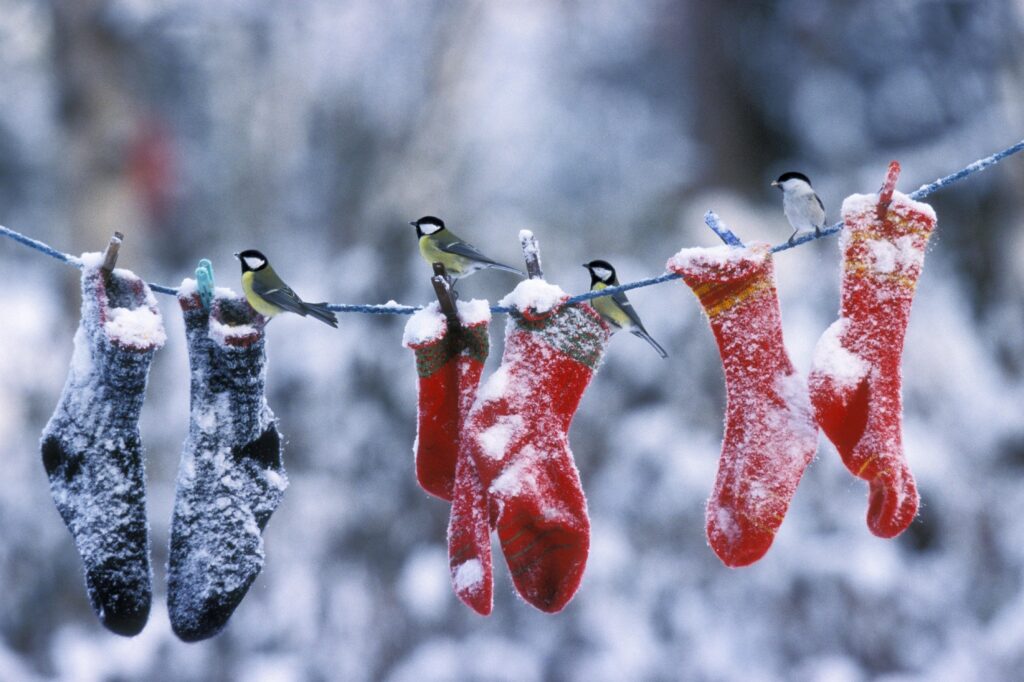
Culture in Kuusamo – heritage defined by the frontier
-
From rock paintings to street art
The soil of Kuusamo has developed into its current form over three billion years. The area rose from an ancient sea 1.8 billion years ago and represents the oldest bedrock in Finland. In relation to soil formation, the era of the human being is short. In Kuusamo, the earliest cultural traces left by humans are probably the rock paintings of Julma-Ölkky: they were not discovered until the 1980s, but they have decorated the rock walls of the canyon lake since the Stone Age, from as far back as 4,500 years ago.
From the rock paintings, we have progressed to the 2020s. Today, the story of Kuusamo and its people is most visibly presented in the photographic work Kyliltä kuultua (Heard in the Villages) by photographer Meeri Koutaniemi, which was erected in the market square in 2015.
These millennia of years have witnessed the stories of many creators: the foremost is one of Kuusamo’s own visual artist, Lahja Koivunen. She was the first artist to systematically portray nature in Kuusamo, and her sensitive works from the 1920s to the 1980s still connect with the emotions of her audience.
The local artists’ society Taiteilijaseura Koillinen, active since 1974, is now an important operator that unites the visual artists of the region. The society has about 50 members, and four honorary founding members: Rauno Salminen, Teuvo Tuomivaara, Eino Vattula, and Hannu Korpua.
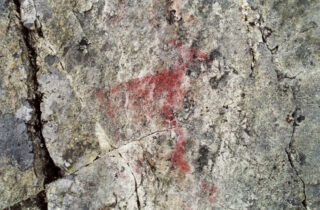
- Rock paintings are figures made with red ochre. They are messages from our distant ancestors.
Photo: Ismo Luukkonen, The Finnish Heritage Agency.
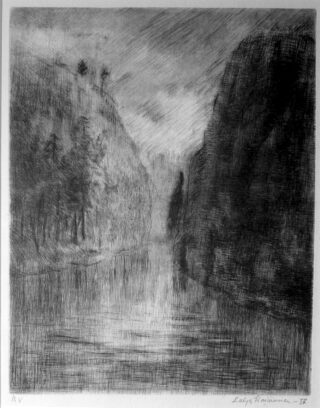
- Artist Lahja Koivunen was a particularly skilled in graphic arts. Julma Ölkky – a drypoint print from 1937.
Photo: Sauli Laaksonen.
- Rock paintings are figures made with red ochre. They are messages from our distant ancestors.
-
The capital of nature photography
During the last half century, Kuusamo has profiled itself as the Nature Capital of the North, where nature photography plays a special role. Nature photography is a natural continuum of the visual arts and professional photography that live and breathe within this community. For decades, the photography studios Kinnusen Kuvaamo and Koillismaan Kuvamo have been important documenters of the local cultural heritage.
Nature photography is most strongly visible in Kuusamo through the Hannu Hautala Foundation. The foundation runs a nature photography centre dedicated to this outstanding photographer. The centre is visited by approximately 10,000 guests every year. Hannu Hautala, the grand old man of nature photography, has done his life’s work in Kuusamo.
The public image of our town is also founded on the work of other nature photographers who have settled here and work here, for whom the eight seasons of Kuusamo present a unique opportunity. The most significant event organized annually by Kuusamo Department of Culture is Kuusamo Nature Photo Festival. In the 2010s, together with the University of Lapland, Kuusamo organized the first nature photography themed master’s degree programme in applied visual arts in Finland. Training in this field is still provided in Kuusamo, in close collaboration with Kuusamo College.
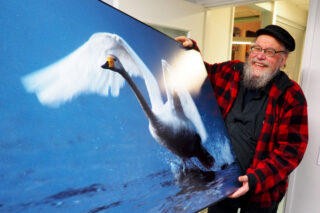
- The whooper swan has been one of the favourite topics of nature photographer Hannu Hautala.
Photo: Ulla Ingalsuo-Laaksonen.
- The whooper swan has been one of the favourite topics of nature photographer Hannu Hautala.
-
Kuusamo is an adventure on the page
Kuusamo appears in Finnish literature in many ways. On hundreds of pages, it is an adventure, but it is also the topic of numerous botanical, geological, social, and historical studies. Rather than in events taking place at its actual location, Kuusamo is present in subordinate clauses, landscapes, states of mind, or characters imprited on memory. Most of the books about Kuusamo are travel stories and memoirs, many of them self-published.
Kaarlo Hänninen, an author, researcher, and MP of the Agrarian League (later the Centre Party of Finland), wrote resolutely about Kuusamo. Reino Rinne, with his extensive literary life’s work, is in a league of his own. The most important writers who have written about local history are Seppo Ervasti, J. Juhani Kortesalmi, Matti Kyllönen, Helena Palosaari, and Pauli Jaakkola. Maija Alajuuma, Meimi Mäntyniemi, Leo Koutaniemi, Markku Myllylä, and Valma Lämsä have also earned a place among the significant writers who have recorded the local history and culture of Kuusamo.
The 2000s introduced Kuusamo to the readers of contemporary Finnish fiction. Authors Tommi Kinnunen, Minna Rytisalo, Petri Vartiainen, and Tuomo Pirttimaa have left the mark of a new generation on stories about Kuusamo, and on the town itself.
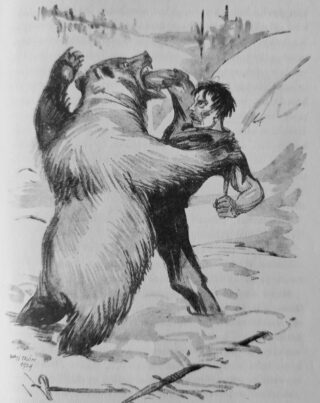
- Kaarlo Hänninen (1876–1939) was an author, researcher, and Agrarian League MP. His literary production comprises 15 novels and two dozen other works. Karhun kosto (The Revenge Of The Bear) was published by WSOY in 1929. The novel was illustrated by Eric Vasström.
-
Waters and hills as soundboard for music
Throughout centuries, music has brought people together, provided comfort, and evoked great emotions. In Kuusamo, hills and waters have echoed as a soundboard of music in revival meetings, political gatherings, and get-togethers with friends.
Church music is the foundation on which a prominent field of local music has been built in Kuusamo. As a result of the work of many proficient cantors, the lively musical culture of Kuusamo has been the launching pad of several professional musicians. Another cornerstone in the foundation of local music is Kuusamo Music College.
The best-known composers from Kuusamo are Tapio Tuomela, Kari Alajuuma, and Kepa Salmirinne. Salmirinne is still a member of the band Zero Nine that achieved international success in the 1980s.
There are also countless songwriters who have written their love for their home country of Kuusamo into melodies and lyrics – at first for themselves, and then for all the people to hear. The songbook Matkalla Kuusamossa – lauluja Koillismaalta (A Journey In Kuusamo – Songs From The Northeast), published by Kari Alajuuma and Pekka Partanen in 2009, contains compositions by 30 songwriters from Kuusamo.
In the promised land of choral music, there is a choir for everyone. In addition to the Parish Church Choir, The Veteran Men’s Chorus, choral choirs, and children’s choirs, there are several other choirs in Kuusamo: Kuusanka, Kuusamon Laulu mixed choir, and Women’s Chorus Ainot. The operation of the famed local mens’ chorus, Kuusamon Mieslaulajat, was ended in 2002 due to the coronavirus pandemic.
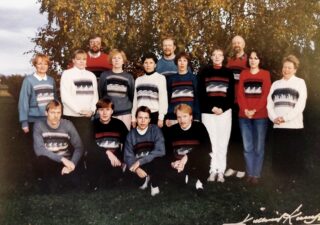
- The flagship of Kuusamo’s choral music, Kuusanka Entertainment Choir, celebrated its 30th anniversary in 2018. Pictured here the choir in 1989, with the singers were wearing their new sweaters devised by Sisko Sormunen for the first time. Later on, the sweaters became the trademark of the choir. Kari Alajuuma, the founder of the choir and choirmaster for the first decades, is in the front row on the right. Photo: Koillismaan Kuvaamo/Timo Litendahl.
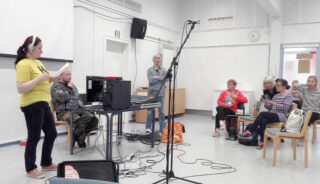
- In Kuusamo, culture means doing things together, beyond the boundaries of art forms. Kuusanka Entertainment Choir participated in the production of the video Pohjoista Voimaa (Northern Power), composed and written by Kepa Salmirinne (centre) and illustrated by Hannu Hautala, in 2018. The sound was mixed by Osku Tuominen. Choirmaster Signe Tamm is on the left.
Photo: Kuusanka Entertainment Choir Collection.
-
Theatre emerges from collaboration
In Kuusamo, the earliest memories of theatrical performances date back to the first years of the 20th century, when Aleksi Alhquist-Salovaara, and Hannes Arola a few years later, got the ball rolling in regard to theatre. Dramatic performances were carried out by the Kuusamo Youth Society and the Kuusamo Workers’ Association, but the activity faded in the turmoil of the First World War. During the interwar period, plays were staged at the Folk High School and some other venues, but there was no purposeful theate activity in Kuusamo.
It was in the dead of winter, in January 1948, when Kalle Karvonen, a multi-talented veteran of the Kuusamo labour movement, invited local people to a founding meeting of a dramatic society at the parish village primary school. Thus, Kuusamon Näyttämö (Kuusamo Stage) was founded, and over the decades this community theatre has gone from one triumph to another.
Having previously worked in a professional theatre, Karvonen started as the manager and director of Kuusamon Näyttämö. When Maija-Leena Ervasti, another arduous theatre lover, moved to the town a few years later, the show really got on the road. The community theatre found a nest from Valistustalo, where big, ambitious productions were seen. Kalle Karvonen was the director, Maija-Leena Ervasti initially led a small-scale group called huoneteatteri (room theatre), and later she also worked as a director in Kuusamon Näyttämö. Years full of colour and interest followed, and all kinds of religious and party-political handwringing has been seen during the decades of the community theatre’s existence.
All in all, drama is alive and well in our town: Kuusamon Näyttamö is an active community theatre with some 80 enthusiasts involved in its operation. The theatre has been a springboard for professional actors, and the contribution it makes to the cultural life in the area is significant. In summer 2021, mainly as volunteer work, Kuusamon Näyttamö built a gorgeous summer theatre in Helikumpu. Winter productions take place either on the Kuusamo College stage, or at Kuusamo Hall.
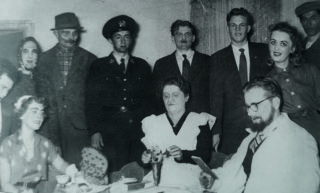
- In 1955, Kuusamon Näyttamö performed the play Sakset (Scissors) written by Artturi Leinonen. The actors in front (from right to left) are Kalle Karvonen, Elli Marttinen and Alli Rautanen, and in the back (from right to left) Samuli Määttä, Maire Korhonen, Jukka Leskelä, Olavi Tuovila, Untamo Nuora, Onni Oksanen, Aira Virtanen, and Paavo Korpua. Photo: the Tuovila family collection.
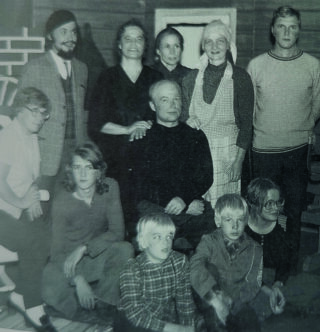
- The play Susipari (Unmarried Couple), written by Kalle Päätalo, was seen on stage in Kuusamo in 1971. Pictured here the directors and actors of the play: in front, on the floor (from right to left) Anne Verronen, Mikko Ervasti, Matti Ervasti, and Seppo Poutanen. Standing in the back row (from right to left) Erkki Ahava, Ulla-Maija Norrback, Hilkka Säilynoja, Eila Tenhunen, and Eero Hänninen. Sitting in the middle Eero Paasovaara, and on the left the director, Maija-Leena Ervasti.
-
“The eyes would eat, but the stomach is full”
In all fields of life, cultural influences have entered Kuusamo from the west, east, and north. The rich food culture of the area draws on the traditions of the west coast of Finland, Russia, and Lapland. Decades later, people remember the traditional holiday treats of the area: rice gruel, fried vendace, salted whitefish, and barley flatbread. Many also include potato gruel, and reindeer soup made from air-dryed meat on the list.
In the old days, soured rye hole-breads were baked only a few times a year. On the baking day the big wood-fired oven was heated, even on a hot summer day. After baking, the hole-breads were hung to dry on long poles suspended under the ceiling, or they were dried in bread cages. In Kuusamo, it was customary to bake barley flatbread once a week.
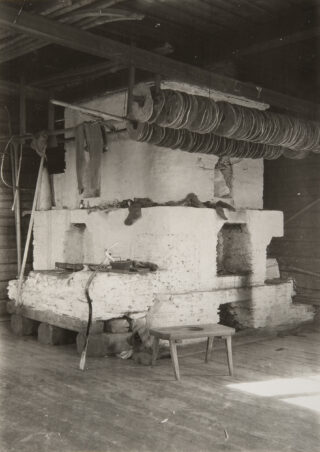
- The central room of the house was dominated by a large oven. There was a flint in the corner of the oven to keep the fire lit. Bread was rarely baked and a lot at once, because the large ready-to-bake oven heated up the room. The oven could bake up to 26 loaves of bread at once.
Photo: Finnish Heritage Agency / Ethnology photo collection, Photographer Ahti Rytkönen.
Nature’s abundant harvest, fresh fish, forest berries, and wild mushrooms, as well as game and reindeer meat, are the best offerings of our local cuisine. In Kuusamo, wild food was refined into products before it became a national and international trend. Local origin, pure ingredients, and traditional, uncomplicated manufacturing methods are valued here. Wild food is used also in the kitchens of our local gourmet restaurants.
In Kuusamo, we are particularly proud of Kitkan viisas (the Sage of Lake Kitkajärvi): our tiny, soft-skinned and tasty variety of vendace. There are various stories about the origin of the name Kitkan viisas, now protected by the EU Designation of Origin. One story tells that the fish was given this name during the Russian revolution, when some people from the Kuusamo region left to Russia to take part in building the socialist ideal state. The small fish was named the Sage of Lake Kitkajärvi, because it was smart enough not to go, although it could have swum down the eastbound rivers and across the border. Another explanation comes from the fact that this small and quick fish is sometimes hard to catch.
The vendace did not cross the border, but the onion did: in the mid–19th century, the local people were taught how to grow onions by Orthodox monks who had settled in Kuusamo. Over the decades, the originally Viena Karelian onion has been refined into a local variety of potato onion.
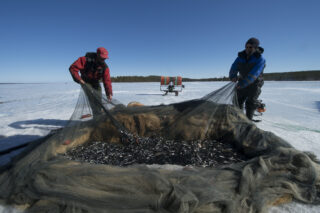
- For centuries, vendace has been the most important fish in Kuusamo. It is caught all year round using traditional methods, i.e. seining and nets. Photo: Paavo Hamunen
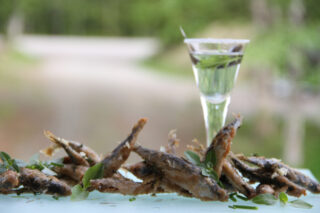
- Fried vendace is a traditional local delicacy. The recipe of Chef Jarmo Pitkänen requires fresh Kitkan viisas vendace, and a batter made from wheat flour, finger salt, baking powder, black pepper, and a can of cold beer. The dried small fish are dipped into the batter and deep-fried in 180°C oil. Photo: Jarmo Pitkänen
- The central room of the house was dominated by a large oven. There was a flint in the corner of the oven to keep the fire lit. Bread was rarely baked and a lot at once, because the large ready-to-bake oven heated up the room. The oven could bake up to 26 loaves of bread at once.
-
Hunting in Kuusamo already in the Stone Age
New settlement spread to Kuusamo in the last decades of the 17th century. However, people have lived, fished, and hunted in the area since the Stone Age. Settlers were attracted to Kuusamo by its abundant fish and game grounds, and an opportunity for slash-and-burn farming. Kuusamo was the melting pot of Sámi, Finnish, Karelian, and Kainuu people, their hunting culture and relationship with nature.
Surrounded by six national parks (Oulanka, Paanajärvi, Hossa, Riisitunturi, Syöte and Salla), the Sukerijärvi Strict Nature Reserve, and the Näränkä Natural Forest, Kuusamo is defined by magnificent wilderness landscapes.
Hunting and fishing still have a strong presence in Kuusamo. Hunting is the main source of meat for many households, and it is also an important part of tourism. One explanation for the strong hunting tradition of the Koillismaa region lies in the terrain: the forest road network is quite sparse, and the traditional man-and-dog pairs prevail when people are hunting birds, hares, small game, bears, and deer.
Another strong aspect in the Kuusamo hunting tradition is the breeding of hunting dogs. In addition to Finland’s national dog, the Finnish Spitz, there are numerous nationally and internationally credited breeders of Karelian Bear Dogs and Finnish Hounds in the area. Together with the Finnish Kennel Club, the people of Kuusamo have made their mark on the breeding of hunting dogs by developing a new recognized breed, the Northern Spitz. Thanks to breeders from Kuusamo, the short-tailed Karelian Bear Dogs, included of the original population of the Karelian Bear Dog, were admitted back to dog shows and trials.
Determined hunting club activity began in Kuusamo in 1950, when the Kuusamo Hunting and Fishing Association was founded. The founding members of the club were a group of socially conscious men: district doctor Ali Ervasti, bank manager Pekka Tirkkonen, watchmaker Reino Tammi, house owner Yrjö Linkola, constable Olavi Hilvo, district forest officer Antti A. Aho, and shopkeeper Onni Saarikumpu.
As a reminder of the spring bear hunt, a private Large Carnivore Center operated in Kuusamo from the 1990s to the 2020s. The centre started as a shelter for bear cubs orphaned during the spring hunt, and initially, it was controlled by Finnish Game and Fisheries Research Institute. Later, it became a rescue centre for not only bears but also wolf-dog hybrids, foxes, and lynxes.
Wildlife viewing and photography also have supporters in Kuusamo. There are several bear photography huts and numerous bird photography huts in the area, where the life of birds such as the golden eagle or the white-tailed eagle can be observed and photographed.
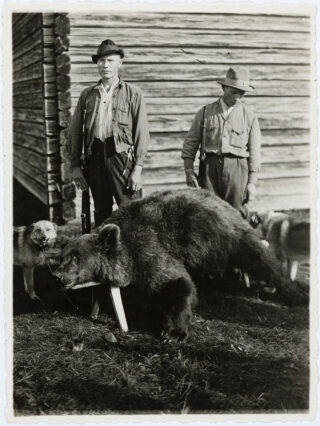
- A hunted bear, bear hunters and their faithful hound photographed in Kuusamo in the 1930s. Photo: The Finnish Heritage Agency/K. Rantala.
-
Traditional landscape is part of our culture
The majority of the Kuusamo building stock was destroyed in the Second World War, but efforts have been made to preserve Kuusamo’s cultural heritage also in the form of old buildings. In addition to Kuusamo Local Heritage Museum, you can admire traditional buildings at Pohjolan Pirtti and Pohjolan Kievari, Vuotunki.
Kuusamo Local Heritage Museum exhibits the life and homestead of a Kuusamo peasant in the 1930s. The museum, founded on the initiative of the Local Heritage Association of Kuusamo, was opened in 1974. The homestead includes 16 buildings moved from different parts of Kuusamo, such as the Pulkkanen cottage, the Rävä house, cowshed, barn, and windmill. The collection of the musum comprises approximately 1,500 objects.
Not only buildings, but also the landscapes of Kuusamo are worth conserving. In 2021, the Council of State added the landscapes of Kitkajärvi and Riisitunturi to the list of nationally valuable landscape areas. Other nationally valuable landscapes in Kuusamo are the cultural landscapes of Määttälänvaara, the Ruka fell range, and the rapid landscapes of rivers Oulankajoki and Kitkajoki.
In Kuusamo, cultural landscapes classified as provincially valuable are the cultural landscapes of Iivaara, Juuma, Kurkijärvi and Purnunvaara, the lake landscapes of eastern Kuusamo, Liikasenvaarantie road, and Julma-Ölkky. Flood meadow landscapes worked on by people of times past can be found along River Oulankajoki.
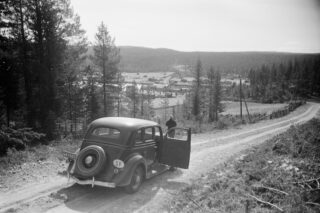
- In 1936, Mrs Nancy Pietinen stopped on her way to photograph the landscape of a Kuusamo village. Photo: The Finnish Heritage Agency/ Collection of Pietinen Photograpic Studio.
-
Wooden boats and Kaijan Hilta’s crocheted mittens
In Kuusamo, the rich tradition of handicrafts goes back centuries. It is a significant part of our cultural heritage. Women have traditionally done needlework, knitting, and weaving, and men have worked with wood and metal. Today, Kaijan Hilta’s crocheted mittens, and the wooden boats of Koillismaa still represent those ancient skills.
The tradition of costume culture in Kuusamo and northeast Finland has been rich and diverse. The Koillismaa woman’s national costume was designed by Toini-Inkeri Kaukonen in 1962, on order of the National Costume Committee of the Koillismaa parishes. The Koillismaa man’s national costume includes features of old-fashioned style of dressing, but also reflects more fashionable style of dressing. The research materials for the model of the man’s costume were gathered from the collections of the National Museum of Finland, from estate inventory deeds, and from private collections. Maija-Liisa Heikinmäki took it upon herself to gather information about the Koillismaa men’s folk clothing. She was assisted by the National Costume Council, and Märtha Keränen from Kuusamo.
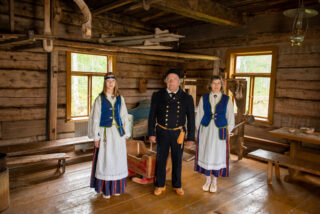
- Toini-Inkeri Kaukonen assembled the Koillismaa woman’s costume in 1962. The costume represents the dressing style of the late 19th century. In addition to Kuusamo, the costume is used in Taivalkoski, Pudasjärvi and Posio.
Photo: Jorma Satta, Kuusamo College.
- Toini-Inkeri Kaukonen assembled the Koillismaa woman’s costume in 1962. The costume represents the dressing style of the late 19th century. In addition to Kuusamo, the costume is used in Taivalkoski, Pudasjärvi and Posio.
-
Influences and wealth from beyond the eastern border
The location of Kuusamo as a neighbour of Russia has brought us a lot of wealth: as the saying goes, life in the border areas is good whenever the border is open. For centuries, the border has been crossed from both sides in order to visit relatives or to trade goods.
In 1953, Arvo Määttä was building a village road and felt his shovel hit into something hard. It was a metal object, left there by ancient travellers. The find proved to be a considerable silver treasure: a silver necklace, under which four more silver neck rings 15–17 cm in diameter were found. About half a metre away was another cache with two bracelets and three silver buckles. In both caches, the items were inside a roll of birch bark. The total weight of the treasure was 0.8 kg of pure silver, and later the origin of the jewellery and the time of its hiding were dated to the time of the Crusades, i.e. 1050–1150 CE. The era was a time of both prosperity and turmoil, and people hid their treasures to protect themselves against robbers.
Life across the border continued to be lively. In the mid–19th century, Old Believer Orthodox monks arrived in Tavajärvi. They established a monastery on the east side of Lake Tavajärvi. The monks had to find a new place to live after the Tuoppajärvi monastery in Viena Karelia had been destroyed by the Russian government in 1852.
The monks bought the dilapidated Hautaniemi crown farm located in Tavajärvi, built three buildings on the farm for the use of the monastery, and erected an Orthodox cross on the top of the nearby Nuorunen fell. Monk Ilja Otso was the abbot of the monastery. As the community of monks grew, hermitages were also established near the monastery in Kiviniemi and Hänninen, for monks living as hermits. The best-known hermit monks were Vasseli aka Vasili Lebedev and Ivan aka Jaakko Parassejev.
The monks of the monastery had close connections with Russia until 1918, when the border was closed and no new residents came to the monastery. Since the late 19th century, the activity of the monastery had began to decline and the last monks died at the end of the 1920s.
Rune singer Marina Takalo also crossed the border and arrived to Kuusamo to enrich the cultural life of the town. She was a master of the old folk poetry, lyrical runes such as those of the Kalevala, the Finnish national epic. A collection of 100 hours of recordings of her singing has been made. In Finland, the Marina Takalo collection is the largest piece of folklore compiled from the oral memory of one person.
Takalo and her family came to Finland in February 1922 as refugees and lived in Määttälänvaara and Heikkilä, among other places. From 1961, Takalo lived in Kemi with her children. She received the recognition award of the Kalevala society in 1965. Marina Takalo died in Kemi in 1970. A commemorative bronze relief of Marina Takalo designed by Nina Sailo was placed in the park of Kuusamo Folk High School in 1990.
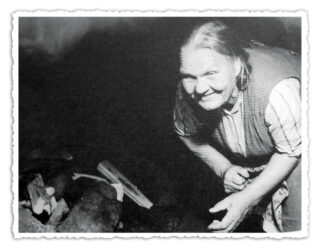
- Marina Takalo was a master of the old folk poetry, lyrical runes such as those of the Kalevala, the Finnish national epic. A collection of 100 hours of recordings of her singing has been made. It is the largest piece of folklore compiled from the oral memory of one person in Finland.
Photo: Juha Pentikäinen
- Marina Takalo was a master of the old folk poetry, lyrical runes such as those of the Kalevala, the Finnish national epic. A collection of 100 hours of recordings of her singing has been made. It is the largest piece of folklore compiled from the oral memory of one person in Finland.
Author:
Ulla Ingalsuo-Laaksonen, MSSc
Translations:
Jonna Lohi, MA, Pivot Translations